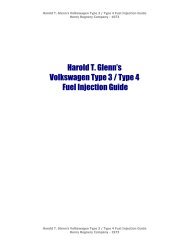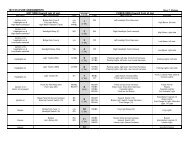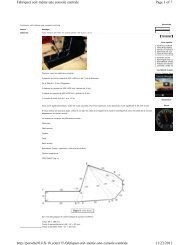D-Jetronic Fuel Injection for the Porsche 914 - Bowlsby.net
D-Jetronic Fuel Injection for the Porsche 914 - Bowlsby.net
D-Jetronic Fuel Injection for the Porsche 914 - Bowlsby.net
You also want an ePaper? Increase the reach of your titles
YUMPU automatically turns print PDFs into web optimized ePapers that Google loves.
D-<strong>Jetronic</strong> <strong>Fuel</strong> <strong>Injection</strong> <strong>for</strong> <strong>the</strong> <strong>Porsche</strong> <strong>914</strong><br />
color. The electrical resistance of<br />
<strong>the</strong> injectors is about 2.4 ohms.<br />
The injectors are very reliable if<br />
given clean filtered gas.<br />
I will cover flow testing and<br />
cleaning in a later section.<br />
Trigger points<br />
Located in <strong>the</strong> base of <strong>the</strong><br />
distributor, <strong>the</strong> trigger points<br />
synchronize <strong>the</strong> injector pulses with<br />
<strong>the</strong> crank shaft. Because <strong>the</strong>y pass<br />
very little current (unlike <strong>the</strong><br />
ignition<br />
points) <strong>the</strong>y can last <strong>for</strong> up to<br />
100,000 mi. There are two sets of<br />
points, one set controls cyl #1 and<br />
#4. The o<strong>the</strong>r set controls cyl #2<br />
and #3. So, if only two<br />
injectors are firing in <strong>the</strong> pairs<br />
described, <strong>the</strong> most likely suspect is<br />
<strong>the</strong> trigger points. To replace,<br />
remove <strong>the</strong> distributor from <strong>the</strong><br />
engine (this is <strong>the</strong> easiest way to<br />
replace <strong>the</strong> ignition points and<br />
condenser, also) and pull <strong>the</strong> trigger<br />
points out after removing <strong>the</strong> two<br />
retaining screws. You may be able<br />
to simply clean <strong>the</strong> points<br />
with a little emery paper. I use a<br />
tiny amount of distributor grease on<br />
<strong>the</strong> parts that rub on <strong>the</strong> cam. When<br />
reinstalling, note that <strong>the</strong>re is some<br />
variability in <strong>the</strong><br />
range setting of <strong>the</strong> points, try to get<br />
<strong>the</strong>m near <strong>the</strong> middle of <strong>the</strong> range.<br />
You can now test <strong>the</strong>m by using a<br />
voltmeter set to <strong>the</strong> ohms scale.<br />
Measure first between<br />
<strong>the</strong> middle connection and one of<br />
<strong>the</strong> outside connections. Spin <strong>the</strong><br />
distributer shaft and you should see<br />
<strong>the</strong> points make and break<br />
connection. Now measure<br />
between <strong>the</strong> middle and <strong>the</strong> o<strong>the</strong>r<br />
side and repeat <strong>for</strong> <strong>the</strong> second set of<br />
points. Replace distributor and don't<br />
<strong>for</strong>get to plug in <strong>the</strong> trigger points.<br />
http://www.rennlist.com/techarticles/djetronicfuel.htm<br />
mounted underneath <strong>the</strong> throttle<br />
body. To test, turn on <strong>the</strong> ignition<br />
and open <strong>the</strong> throttle with your<br />
hand. You should be able to hear<br />
<strong>the</strong> injectors firing, a sort of<br />
"brrrrrrp" noise. If working<br />
correctly, <strong>the</strong> injectors will fire 20<br />
times <strong>for</strong> <strong>the</strong> full range of<br />
movement. One very mysterious<br />
intermittent<br />
fault caused by <strong>the</strong> throttle switch is<br />
an occasional "bucking" while<br />
driving at constant speed. This is<br />
caused by <strong>the</strong> switch cutting of <strong>the</strong><br />
fuel and <strong>the</strong>n turning it back<br />
on. Test by disconnecting <strong>the</strong><br />
switch (it is amazing how well <strong>the</strong><br />
car will run without it, actually),<br />
you will notice that acceleration<br />
will be a little sluggish as <strong>the</strong><br />
"accelerator pump" action will be<br />
missing.<br />
Pressure Sensor<br />
Page 3 of 10<br />
Located at a bracket near <strong>the</strong><br />
battery, <strong>the</strong> pressure sensor is <strong>the</strong><br />
single most important sensor in <strong>the</strong><br />
fuel injection system. Consisting of<br />
an iron core surrounded by<br />
a pair of coils, mechanically<br />
connected to a thin metal<br />
diaphragm, this sensor measures <strong>the</strong><br />
pressure at <strong>the</strong> intake air distributor<br />
relative to <strong>the</strong> ambient pressure<br />
(that is, it can correct <strong>for</strong> changes in<br />
altitude).<br />
It can fail in several ways. The coils<br />
can develop an electrical fault, or<br />
<strong>the</strong> diaphragm can leak. A defective<br />
sensor will often result in a very<br />
rich running condition.<br />
However, I have seen one fault<br />
resulting in <strong>the</strong> mixture becoming<br />
so lean that <strong>the</strong> engine wouldn't run.<br />
The coils can be tested by<br />
measuring <strong>the</strong> resistance between<br />
terminals #7 & # 15 (should be<br />
about 90 ohms) and between #8 &<br />
#10 (should be about 350 ohms).<br />
12/18/2007







